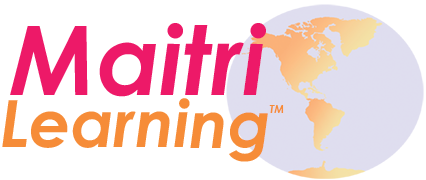Developing the attention span via polishing
Parents often ask Montessori teachers why their children are cleaning the school. Children in Montessori early childhood classrooms are learning how to wash dishes, sweep the floor, dust, and even polish silver. Can't the school afford to hire their own cleaning staff?
The answer has nothing to do with keeping the classroom clean. In fact, teachers often have to go back after school and "re-clean" what the children have cleaned. The reason we teach them these "practical life" activities is all about aiding the child's development.
A mom I know on Instagram (big shout out to @montessoriinmotion) posted a video of her daughter that illustrates some of the benefits of practical life activities. It's just over one-minute long and is so rich in things to notice that I asked her permission to write about it here. Watch the video on your own first and then read on (and yes, she is sporting the matching Maitri Learning blue flower apron and mat).



 child’s interest and abilities. Keep in mind that we always want the child to think that they are too smart for the work, not that the work is too hard for them. When they witness themselves succeeding, their self-confidence will grow.
child’s interest and abilities. Keep in mind that we always want the child to think that they are too smart for the work, not that the work is too hard for them. When they witness themselves succeeding, their self-confidence will grow.


 My dear friend Susan Banon* went through great pains to put together a list of books that she could recommend for families (in English and French). She collaborated with me and other Anglophones/Francophones and together we all came up with the results listed below. Of course, there are so many more books that we could recommend; it would be impossible to give you a finite list. Instead, we just wanted to wet your whistle and get you started.
My dear friend Susan Banon* went through great pains to put together a list of books that she could recommend for families (in English and French). She collaborated with me and other Anglophones/Francophones and together we all came up with the results listed below. Of course, there are so many more books that we could recommend; it would be impossible to give you a finite list. Instead, we just wanted to wet your whistle and get you started. Sometimes the children in our classrooms seem about as far away from our vision of the Montessori “normalized” child as they can get! Don’t worry. The potential to concentrate and manifest peace is actually there within every child (and adult). Here are a few quick points to help you remain calm and be helpful if you find yourself with a room full of firecrackers.
Sometimes the children in our classrooms seem about as far away from our vision of the Montessori “normalized” child as they can get! Don’t worry. The potential to concentrate and manifest peace is actually there within every child (and adult). Here are a few quick points to help you remain calm and be helpful if you find yourself with a room full of firecrackers.

